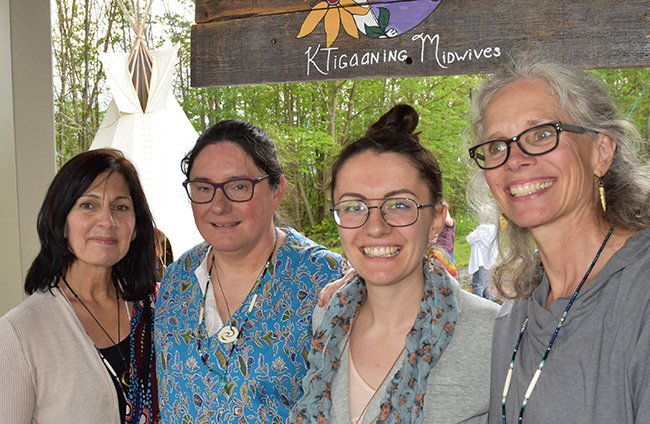Babies arriving into world on Nipissing First Nation

By Kelly Anne Smith
Upon arrival at the Grand Opening of the K’Tigaaning Midwives, mom Carrie Arra Silas was leaving with Romea in a baby carrier while an Indigenous woman from New Zealand was helping by carrying an identical brother named Oakland in a carrier to mom’s car.
Joanne Rama is a visiting Maori midwife in colourful clothes and a long half purple braid who said she came all the way from New Zealand for the grand opening on Couchie Industrial Road. Rama laughed and said she was also in Canada for the huge midwifery conference in Toronto. She stayed longer to visit and attend K’Tigaaning Midwives grand opening as did others from Australia, South America and Africa.
On June 23, 4000 midwives from around the globe travelled to Toronto to attend the International Confederation of Midwives Congress. Speaking at the tri-annual conference, Canada’s health minister Jane Philpott announced $6 million over five years in additional funding for midwifery services in Indigenous communities. “It is vital to support midwifery care which will bring traditional birthing practices back to these communities, better support mothers and their babies and build strong families,” Philpott said in a news release.
A mother bear and her baby cub had been seen close by the clinic on Nipissing First Nation land so a female Anishinabek police officer was warning folks at the grand opening to be alert.
A sacred fire burned in the teepee. A proud Chief Scott McLeod addressed the gathering. There were happy kids playing on the blow up slide and there were little babies everywhere. Indoors, a huge feast was laid and happy parents and midwives chatted.
Rachel Dennis has been operating K’Tigaaning Midwives with her mother Carol Couchie, offering culturally appropriate midwifey services in a clinic setting and at home births. The Nipissing First Nation members also have hospital privileges. Audrey ten Westeneind is another qualified midwife practising with K’Tigaaning.
Dennis says opening the practice on Nipissing First Nation is significant. “It’s on reserve in our community. We have a big focus on bringing birth back to Indigenous communities.”
She talks about K’Tiganning Midwives receiving funding through Ontario’s new Indigenous Midwifery Program. “We are growing our services to include ‘teaching kitchens’, and pre-natal classes and other programming. We can also expand our care. We can offer home visiting for people who are in the care of an obstetrician if they are high-risk or if they didn’t call soon enough for a spot.”
“We have another Indigenous midwife, Emily Chartrand-Hudson, who will be joining the practice in September. Emily will be offering on-call services while my mom Carol will be offering lots of mentoring for Emily as well as offering additional services here like the workshops in a grandmother-elder role.”
Accessibility to the birthing facility is appealing for mothers to be. At K’Tigaaning Midwives, about twelve babies were born in the roomy birthing room with the large tub. Water births give babies a gentler welcoming and can be easier on mom’s body. New mom Julie Bamford-LeBlanc proudly held 6 week old McKenna. “I wanted to have a water birth. There is a beautiful huge tub here that I had a water birth in. I laboured in it the whole time and that’s where she was born. It was amazing and everyone was so helpful.”

